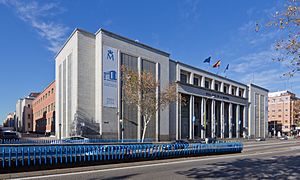Royal Mint (Spain) facts for kids

Headquarters at Calle del Doctor Esquerdo Nº 36, Madrid
|
|
| Statutory corporation | |
| Industry | Mint |
| Predecessor | Casa de la Moneda Fábrica del Sello |
| Founded | August 1893 |
|
Area served
|
Spain |
| Owner | Government of Spain |
| Parent | Ministry of Economy |
The Royal Mint of Spain is also known as the Fábrica Nacional de Moneda y Timbre – Real Casa de la Moneda (FNMT-RCM). It is Spain's official place for making money. This includes coins and banknotes. The Royal Mint is a public company. It works closely with the Ministry of Economy in Spain.
Contents
History of Spain's Money Makers
For a long time, Spain had many different places that made coins. Some were run by the government, and others were private. In the 1700s, Philip V became the first Borbòn King of Spain. He decided that only the government should make coins. This made it a "State monopoly," meaning the government had total control.
Mints Across Spain
Later, during the time of Isabella II, there were seven official mints. These were in cities like Madrid, Barcelona, and Seville. Each mint had its own special mark. In 1869, the peseta became Spain's main money. At that point, only the Royal Mint in Madrid was still making coins.
Joining Forces: Mint and Stamp Factory
In 1893, two important places joined together. One was the Mint (Casa de la Moneda), which made coins. The other was the Stamp Factory (Fábrica del Sello), which made stamps. They used to share a building in Madrid. When they merged, they created the Fábrica Nacional de Moneda y Timbre.
New Products and Buildings
The Royal Mint started printing banknotes for the Bank of Spain in 1940. In 1964, a new, bigger building was opened. Here, they began making passports and national ID cards. Later, they also started printing tickets for the state lottery.
The Royal Mint Today
Today, the Royal Mint has two main locations. One is in Madrid, and the other is in Burgos. The Burgos plant is very important because it has the paper mill. This is where the special paper for banknotes is made. Many of the products from the Royal Mint have an ISO 9001 quality certificate.
Making Euro Banknotes
In 2015, a new company called Imprenta de Billetes, S.A. (IMBISA) was created. Its main job is to print Euro banknotes. The Banco de España (Spain's central bank) owns 80% of this company. The Royal Mint (FNMT-RCM) owns the other 20%. This change happened because of new rules from the European Central Bank. These rules said that countries could either print their Euro banknotes at their own central bank's printing works or hire outside companies. Spain chose to have its central bank involved.
Museums to Visit
The Royal Mint has a museum inside its main building in Madrid. It's called the Museo Casa de la Moneda. You can learn all about the history of money and how it's made there.
There's also another historical mint in Segovia. This old mint also has its own museum for visitors.
See also
 In Spanish: Fábrica Nacional de Moneda y Timbre para niños
In Spanish: Fábrica Nacional de Moneda y Timbre para niños
- Casa de Moneda de Jubia
- Spanish peseta
- La casa de papel

